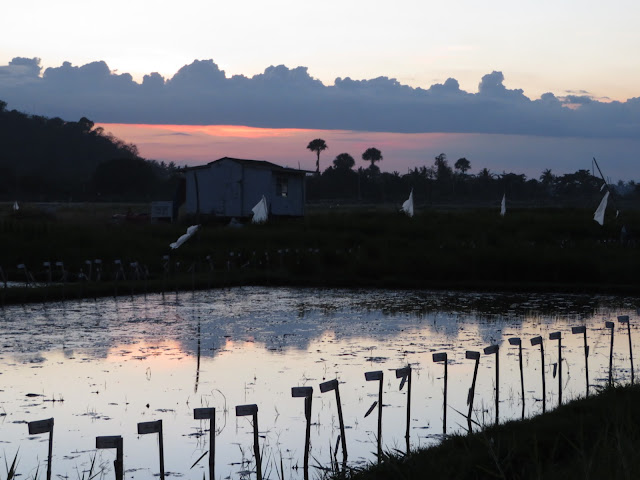My last bird-watching walking tour at IRRI
Summer was in full swing when I took my usual afternoon walk with Krishna and Ate Mary, not knowing that this was my last afternoon roaming IRRI's world-famous experimental station (I moved to California a few weeks later). I intended to take photos because the sky was largely clear. Maria Makiling was fully visible for a change.
Walking at sunset to photograph birds with a point-and-shoot was not ideal, I know, but I also wanted to exercise for a bit. I was happy that we took the time to get out of our desks to walk because the sunset behind FF Hill and Chandler Halls was glorious. It's something I'd miss when I moved to the other side of the Pacific because the course I was taking did not allow for a lot of free time (I'm currently studying data analytics at UC Berkeley).
Some of the roadside fields were being prepared for planting during this last walk of mine. There were no bird tapes, scarecrows, or "bird boys" at this point in the planting season because there were no rice grains that would attract birds onto the fields. Instead, the fields were lined with bamboo sticks with label flags.
In fields that were not yet prepared for planting, however, we found many birds. I'm still amazed at how these birds could perch on grass stalks. They are so lightweight!
 |
| Chestnut munia |
The chestnut munia was one of the birds I first saw in the "Birds of IRRI" calendar. This was the first time I was able to photograph one. Reading up about it, I learned that it is the maya that used to be the Philippine national bird (until the Philippine eagle became the national bird). I always thought that the Eurasian tree sparrow was the maya; but I was corrected.
 |
| Cattle egret |
The cattle egret has always been present in the IRRI fields. This one just caught my eye because it featured orange feathers. They're typically all white. Apparently, it's breeding season for these birds; hence the more colourful plumage.
 |
| Oriental pratincole |
I felt happy with this walk because it was the first time I noticed the presence of the oriental pratincole. Actually, I saw a lot of them while we were walking. And they were not afraid of people walking on the dirt road at all. Like the egrets, they just avoided us when we got too close but they didn't fly away.
I think that the birds flying in formation were egrets but I couldn't be sure with the gathering dusk.
 |
| Brown shrike |
The brown shrike was the bird I kept seeing but I couldn't photograph until this walk. I also mistook this bird for the Eurasian tree sparrow so I used to not take a closer look at this bird... until one sat on a nearby barbed wire and exhibited its unique plumage. Ate Mary, Krishna, and I had to stop walking just to take a look at this bird before it flew off.
Many of these birds are migratory, with IRRI as their winter grounds. Reading through the IRRI documentation about these birds, I started to appreciate them more and took an interest that led to several posts about birds during my trips. This is one of the things, aside from science, that I appreciate about my long stint at IRRI. My walks are something that I surely miss.





Comments
Post a Comment
Thank you for dropping by!
Before moving on, please share your thoughts or comments about the post. :)
Thanks again!